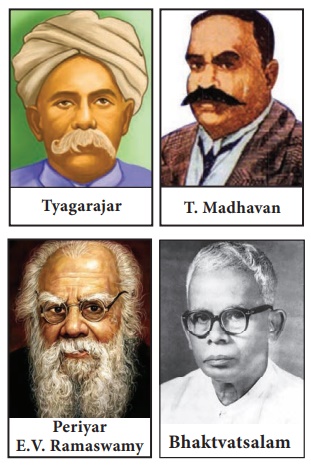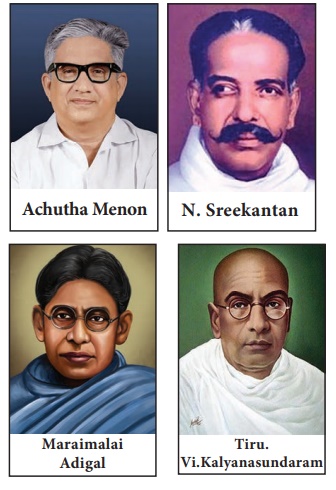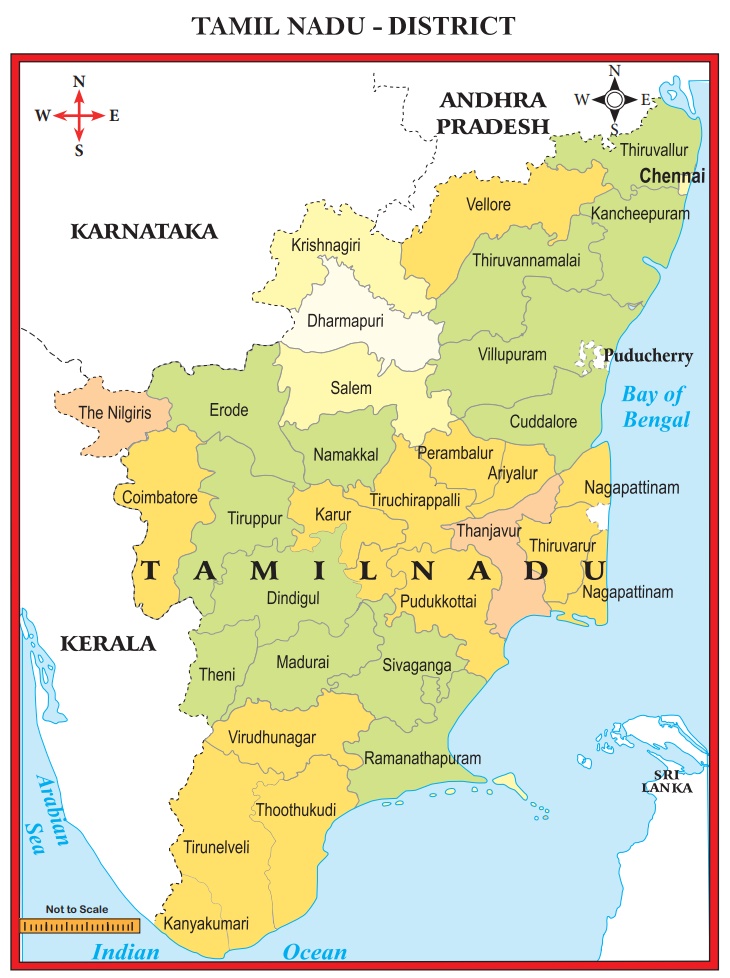Chapter: 12th Political Science : Chapter 7 : Challenges of Nation Building
Formation of Tamil Nadu State
Formation of Tamil Nadu State

In the year 1802, Lord Wellesley created the Madras
Presidency. Until the second half of the 18th century, the different small
Kingdoms ruled South India. The British conquest of South India led to the
integration of different Kingdoms into one. This Madras Presidency was an
administrative subdivision of British India. This administrative subdivision
included the present day Tamil Nadu, Andhra Pradesh, some parts of Odisha,
Kerala, Karnataka and the Lakshadweep. After the Independence Madras Presidency
became the Madras State. Then due to the linguistically based reorganisation of
Indian States on November 1, 1956, the new separate State for Tamils was
created that was formerly known as the Madras State. Later the name of Madras
State was renamed as Tamil Nadu after the great political struggle of Tamil
people.
The Emergence of Linguistic Nationalism
In the early 20th century along
with the national consciousness, the linguistic regional consciousness also emerged
in the different parts of India due to the influence of the vernacular press
and regional political associations. The ‘Indian Nation’ imagined by the Indian
National Congress, a leading body of Nationalist movement contained several
problems. One of the problems was it gave the honoured position of national
language to Hindi. This created the way for the emergence of Tamil linguistic
sub-nationalism in the second decade of the 20th century. It witnessed the
emergence of the non-Brahmin movement as a complex issue that included caste
conflict, linguistic nationalism and class struggle. T. Madhavan, Tyagaraja,
and other non-Brahmin leaders formed the South Indian Liberal Federation.

Later it was popularly known as
the ‘Justice Party’. Justice Party was had contested in the provincial
elections of Madras at 1920, and it emerged victoriously and formed the
government. From 1920 to 1937, it formed four out of the five ministries.
Finally, it lost to Congress in the 1937 election, it never recovered. Later
emerged the leadership of Periyar E.V. Ramaswamy and his ‘Self-respect
Movement’. These movements created great influence in the Tamil people’s
cultural and political life. The consciousness of Tamil nationalism emerged in
South India due to the impact of these movements.
The Idea of Dravida Nadu
Indian National Congress strengthened its
organisation in Tamil country through the Civil- Disobedience Movement. In
1937, Congress won the Madras legislative assembly election and Rajaji became
the Chief Minister. After that he prioritised and implemented two public
policies, first one was abolishing untouchability and the second one was
adopting Hindi as the National language. Rajaji announcement that Hindi should
be a compulsory subject in schools was perceived as an insult to the
non-Brahmins pride as Dravidians/Tamilians. EVR Periyar and other Self-respect
Movement members organised marches and massive anti- Hindi conferences. (Shiga
Miwako and Karashima Noboru, Ed. 2014) Tamil scholars like Maraimalai Adigal,
Tiru.Vi.Kalyanasundaram and others convened a lot of public meetings and
created awareness among the people about the imposition of Hindi. EVR Periyar
extended his wholehearted support to this agitation. He raised even a slogan,
‘Tamil Nadu Tamilarukke’ (Tamil State for Tamils). He organised the Dravida
Nadu Conference in 1939 and demanded the separate Independent ‘Dravida Nadu’.

Kamarajar and Rajaji
A consequence of this protests was the demand for
the separated state for the non-Brahmin people, which also included the Tamils,
Telugus, Kannadigas and Malayalees. In 1944, E.V. Ramasamy reorganised the
Justice Party into Dravidar Kazhagam in the Salem conference in order to streamline
the voice of the Tamils upon the social cause and for the upliftment of the
Tamils. Periyar’s Salem Conference was noted for its militancy and mass
arousing spirit. Now, the object of the Dravidar Kazhagam was to proclaim a
sovereign independent Dravidian Republic, which would be federal in nature with
four units corresponding to the linguistic divisions, each having residuary
powers and autonomy of internal administration. However, the struggle for
Dravida Nadu could not get the support outside the Tamil speaking territory
The Idea of the State of Dakshina Pradesh
Rajaji initiated the creation of a new concept of
political state in South India. This initiation was to counter the Dravida
movement. Dakshina Pradesh means the
amalgamation of Tamil Nadu and Kerala. He spread his ideology through his
followers like C.Subramaniam, Bhaktvatsalam, and some others. Rajaji’s
political idea was vehemently opposed by most of the political parties of South
India. Sreekantan of the Revolutionary Socialist Party, Achutha Menon of Cochin
Communist Party and A.K.Gopalan leader of the Travancore Communist Party
strongly opposed the idea of the State of Dakshina Pradesh. E.V. Ramasamy wrote
an editorial column in the press, Viduthalai
and requested all Tamils to send telegrams against the formation of Dakshina
Pradesh to the Chief Minister of Madras Government. Meanwhile, the people of
Karnataka also opposed the concept of Rajaji, particularly Sardar Sarana Gowda
of Karnataka People’s Party. However, Rajaji and his supporters once again
raised the concept of Dakshina Pradesh at Amritsar Congress Conference in 1956.
There, K.Kamaraj, Chief Minister of Madras State reflected people’s resistance
and stood against Dakshina Pradesh. He opposed the Dakshina Pradesh concept in
all the public meetings and it had aroused a great spirit among the Tamils, who
were ready to fight against the concept of Dakshina Pradesh.

Linguistic Reorganisation of Indian States after Independence
The demand of States on linguistic basis was
developed even before the independence of India under British rule. After
independence, the first ten years of nation-building between 1947 and 1956 saw
the issue play a decisive role again and prompted the formation of two major
policy directions: one was the official language policy and other the
reorganisation of States, that is, federal restructuring. The reorganisation of
the States on the basis of language, a major aspect of national consolidation and
integration, came to the force almost immediately after independence.
The boundaries of provinces in pre-1947 India had
been drawn in a haphazard manner as the British conquest of India had proceeded
for nearly a hundred years. NO heed was paid to linguistic or cultural cohesion
so most of the provinces were multilingual and multi-cultural. The case for
linguistic States as administrative units was very strong. Language is closely
related to culture and therefore to the customs of people. Besides, the massive
spread of education and the growth of mass literacy can occur through the
medium of the mother tongue. Democracy can become real to the common people
only when there is politics and administration or judicial activity unless a
state is formed on the basis of such a predominant language.
Formation of Tamil Nadu
The formation of Tamil Nadu, based mainly on
political trends and conceived after the linguistic status reorganisation,
emerged as an offshoot of the freedom struggle of India. The trends and
development in the socio-political scene of Madras- based on the Linguistic
Movement. The States Reorganisation Commission submitted the final report in
1955. It recommended the creation of the States of Madras, Mysore, and Kerala.
According to States Reorganisation Commission, the new Madras State came into existence
on 1st November 1956. The States Reorganisation Act, 1956 was a major reform of
the boundaries of India’s States and territories, organising them along
linguistic lines. The State Reorganisation Commission recommended on the basis
of the percentage of the people speaking Tamil, in the four taluks namely
Agasteeswaram, Thovalai, Kalkulam, and Vilavancode to Tamil Nadu from the State
of Travancore. The same yardstick was applied for the transfer of Shenkotta
taluk to Tamil Nadu. However, while dealing with Devikulam and Peermedu
(Idukki), even though the majority was Tamil speaking people and the
representatives to the State assembly were Tamils the Commission used a
different yardstick and recommended to retain in Travancore – Cochin State due to
geographical reasons. For the first time in history Tamil Nadu has been created
as a distinct linguistic State.

Struggle for Renaming Madras State into Tamil Nadu
After the attainment of a separate State for
Tamils, they were not fully satisfied since they wanted to change the name of
the State from Madras to Tamil Nadu. The struggle for the renaming of Madras
State into Tamil Nadu continued for more than a decade. The States
Reorganisation Commission had not recommended for the adoption of the name
Tamil Nadu for the reorganised Madras State. Ma.Po. Si, tireless efforts an
all-party conference was convened on 27th January 1956 which called for a
general hartal on 20th Feb 1956. A number of protests and agitation took place
in Madras State. Sankaralinganar, a freedom fighter and one of the disciples of
Gandhi who belonged to Virudhunager demanded to rename Madras State as Tamil
Nadu. He observed fast unto his death from 27 July 1956 to his last breath on
13th October 1956. The death of Sankaralinganar created a mass struggle in
Madras State. College students, labourers, women, and different organisations
openly participated in the movements. Later this affected the politics of Madras
State. Owing to the influence of these movements, Congress lost its popularity
among the people. Finally, it reflected in the 1967 general election, when
Congress was totally swept away from Tamil Nadu and Dravida Munnetra Kazhagam
(DMK) captured political power. DMK renamed the Madras State as ‘Tamil Nadu’.

Multi Culturalism, Diversity and Process of Nation Building
The new Indian nation evolved during the
post-mutiny colonial period, through the national movement, was inspired by
past experiences, and emerging ideas of democracy, liberalism and federalism.
The age of monarchies were gone forever, the era of religious states too were
gone. In an age of liberal democracy, peoples’ will, rights and their
linguistic, cultural identities, and their economic development have to be the
basis of nation building. The great nation builders of modern times like
Mahatma Gandhi and Jawaharlal Nehru were against religious or cultural
nationalism (Hindu Nationalism, Muslim Nationalism or Two-Nation Theory. They
acknowledged the plural base of emerging new India, hence advocated a
democratic liberal and federal India. However, many thinkers have pointed out
that the constitution of our New India through called India a union of states
did not provide adequate financial and political powers for the constituent
states. Over centralization along with insistence on a single national-official
language (i.e.Hindi) replacing English would erode into the cultural and
linguistic identity of the constituent regions. Jawaharlal Nehru could see the
perils involved in replacing English with Hindi, hence gave an assurance on the
continuance of English as long as the non-Hindi people desired the same.
Activity
Trace the various movements in different cities within Tamil Nadu during the formation of the State. What were the different rallies and protests other than the ones mentioned in the text organised across Tamil Nadu?
Related Topics